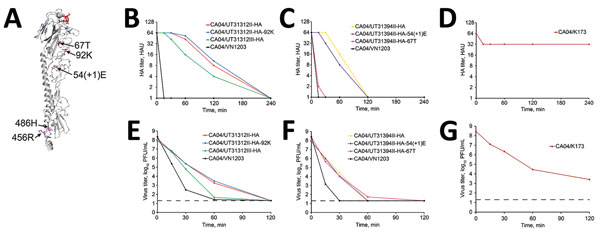Volume 24, Number 7—July 2018
Research
Diversity of Influenza A(H5N1) Viruses in Infected Humans, Northern Vietnam, 2004–2010
Figure 4

Figure 4. Effect of amino acid variations in HA on virus thermostability in influenza A(H5N1) virus isolates from humans, northern Vietnam, 2004–2010. A) Amino acid substitutions in non–receptor-binding domains mapped on the 3-dimensional structure of the monomer of VN1203 HA (Protein Data Bank accession no. 2FK0). Red indicates modeled human-type receptor; purple indicates positions of amino acid variations on the non–receptor-binding domains; blue indicates positions of amino acid variations on the receptor-binding domain corresponding to Figure 2, panel A. B–G) Thermostability of HA variants depicted in panel A. Amounts of viruses equivalent to 64 HA units were incubated at 55°C for 15, 30, 60, 120, and 240 min. B–D) HA titers in heat-treated samples were determined by performing HA assays with 0.5% turkey red blood cells: B) CA04/UT31312II-HA, CA04/UT31312II-HA-92K, CA04/UT31312III-HA, CA04/VN1203; C) CA04/UT31394II-HA, CA04/UT31394II-HA-54(+1)E, CA04/UT31394II-HA-67T, CA04/VN1203; D) CA04/K173. E–G) Virus titers of heat-treated samples determined by means of plaque assays in MDCK cells. Shown are the mean HA or virus titers of triplicates from a single experiment. Dashed lines indicate the detection limit for virus titration (20 PFU/mL). E) CA04/UT31312II-HA, CA04/UT31312II-HA-92K, CA04/UT31312III-HA, CA04/VN1203; F) CA04/UT31394II-HA, CA04/UT31394II-HA-54(+1)E, CA04/UT31394II-HA-67T, CA04/VN1203; G) CA04/K173. CA04/K173 virus was used as a control. HA, hemagglutinin.
1These authors contributed equally to this article.